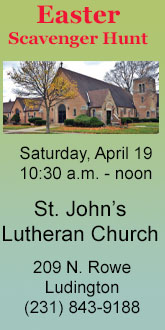
Hiram Scott
MC Memories: The naming of Scottville.
MC Memories is a weekly history column brought to you by Ludington Woods Living and Memory Care. Each week this column will feature a story from our county’s past.
Editor’s Note: I have always been interested in history, especially local history. I think it’s important that we know where and who we came from. It gives us a better understanding of where and who we are today. One of the topics I plan on writing about is how some of the communities in Mason County got their names. We begin with Scottville.
By Rob Alway, Editor-in-Chief.
Legend has it, from many accounts, that Scottville was named by a flip of a coin, which was instigated after a scandal.
Scottville’s modern roots date back to 1860 when the first non-native people began settling in the area. The main road between the settlement and Lincoln (Ludington) was located south of where the railroad tracks are now located, in the general area of First Street. The road was very rough and used mainly by the lumber industry to haul supplies from Lincoln to the lumber camps on the eastern side of the county.
The firm of Sweetland, Mustard, and Winters established a sawmill in the settlement in an area located at the modern northeast corner of Blaine and Paul streets. James Sweetland, the primary partner, named the town after himself, Sweetland. There are historical accounts that state the town was also known as Mason Center.
 Transportation sealed the fate of the town of Sweetland, making it more successful than some neighboring settlements. The railroad made its way into Sweetland in 1874. At that time, another settlement was located west of the town known as Jordan, located near the present site of Great Lakes Energy’s offices. Further to the west was Amber, located near the present site of Amber Road and the railroad crossing.
Transportation sealed the fate of the town of Sweetland, making it more successful than some neighboring settlements. The railroad made its way into Sweetland in 1874. At that time, another settlement was located west of the town known as Jordan, located near the present site of Great Lakes Energy’s offices. Further to the west was Amber, located near the present site of Amber Road and the railroad crossing.
Sweetland’s advantage, though, was that it was the site of a crossing over the Pere Marquette River. In addition, in 1875, the first north-south road along the Amber-Custer townships line was established. This road eventually made its way to Manistee. The east-west road also saw improvements. A road along what is now First Street ran west out of town and then angled its way north, west of Amber on a route that is roughly in the area of the modern US 10 and Johnson Road. Because of these elements, Sweetland (Scottville) survived while the other settlements eventually faded away into ghost towns.
In 1882, the town name changed. In the book, “Back Home with Ruth,” June Newkirk’s narrative biography of Scottville pioneer Ruth Bishop Falconer (Vantage Press, 1976), Falconer described a “scandal” that took place involving James Sweetland. Falconer was a child at the time, and she and her mother was living in a boardinghouse operated by Sweetland.
“James Sweetland’s wife had given birth to twin daughters and, while she was still bedridden, Sweetland ran off with an Indian (woman) and never returned,” Newkirk wrote. Sweetland, she continued, died years later in New York state.

Picture of Scottville, looking south on Main Street from an area in front of modern city hall. Cica. early 1900s.
A town meeting was held, Newkirk wrote, and it was decided that the town should be renamed. “George Reader and Hiram Scott stated that they would not live in a place named for a man who would do such a deed as that. So Hiram Scott and his business manger, George Reader, tossed a coin on the main corners of town (where the stoplight would one day be located). Scott won the honor of renaming the village and so he named it Scottville. Reader named State and Main streets. A few years later, Reader was also instrumental in getting the village incorporated.”
Historical accounts are slightly contradicting about whether Scott worked for Reader or if they were business partners. One account states that he was a “young lad” when he began working for Reader. It’s likely that at some point, he became partners with Reader. The store was located by the railroad tracks, likely just north of the Sweetland, Mustard, Winters sawmill, because it has also been described as the railroad depot. Scott was described by Newkirk as a business owner and also a teacher.
That same year, Charles Blaine and Hiram Scott platted the town. The first streets were Main, State, Blaine, and Crowley. In 1889, Scottville was incorporated as a village. Its status changed to city in 1907.
According to his gravestone at Oak Grove Cemetery in Manistee, Hiram Scott was born in 1849 in upstate New York, meaning he was 33-years-old when he named Scottville. Census records contradict that information and state he was born in 1858. He was the son of Eliphalet and Laura Ann Scott. In 1860 his family was living in Caledonia, Mich. In 1878 he married Josie Dunham, who died sometime between then and 1880. In 1881 he married Jennie Carrier from Manistee. They had one daughter, Blanch, born in 1889.
According to census records, the Scotts had moved to Manistee by the mid-1890s.
Census records state in 1910 and 1920 he was a lumber inspector there. Hiram Scott died in 1924, at the age of 74, and is buried at Oak Grove Cemetery. Jennie died in 1960 in Manistee at the age of 95 and is buried at Oak Grove Cemetery. According to her obituary, the Scotts had no living children when she died.
Ludington Woods Assisted Living and Memory Care, 502 N. Sherman St., Ludington, MI 49431; 231-845-6100; www.ludingtonwoods.com.











































.png)




















